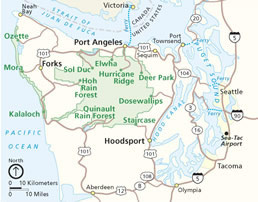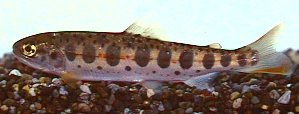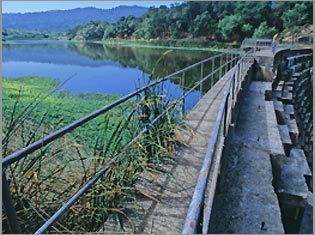This article needs additional citations for verification .(September 2014) (Learn how and when to remove this template message) |
Indian Creek is a tributary of the Elwha River located in Washington in the United States.

A tributary or affluent is a stream or river that flows into a larger stream or main stem river or a lake. A tributary does not flow directly into a sea or ocean. Tributaries and the main stem river drain the surrounding drainage basin of its surface water and groundwater, leading the water out into an ocean.

The Elwha River is a 45-mile (72 km) river on the Olympic Peninsula in the U.S. state of Washington. From its source at Elwha snowfinger in the Olympic Mountains, it flows generally north to the Strait of Juan de Fuca. Most of the river's course is within the Olympic National Park.
Indian Creek flows from Lake Sutherland into the former Lake Aldwell. Historically, Indian Creek supported runs of several anadromous salmon and trout species, including all five species of Pacific Salmon. However, with construction of the Elwha Dam in 1913, fish were blocked from accessing the Pacific Ocean.
Lake Sutherland is located on the Olympic Peninsula about 17 miles (27 km) west of Port Angeles, Washington. The lake is located just to the east of Lake Crescent. Lake Sutherland drains into Indian Creek, which is a tributary of the Elwha River.

Lake Aldwell was a reservoir located about 4.9 miles (7.9 km) from the mouth of the Elwha River on the Olympic Peninsula in the state of Washington. The reservoir was created in 1913 behind the Elwha Dam, which was fully removed in 2012. The Elwha Dam blocked 70+ miles of fish habitat for Pacific Salmon and steelhead within Olympic National Park.

Salmon is the common name for several species of ray-finned fish in the family Salmonidae. Other fish in the same family include trout, char, grayling and whitefish. Salmon are native to tributaries of the North Atlantic and Pacific Ocean. Many species of salmon have been introduced into non-native environments such as the Great Lakes of North America and Patagonia in South America. Salmon are intensively farmed in many parts of the world.
While the Elwha Dam was in operation, Indian Creek sustained populations of kokanee sockeye salmon, which spawned in Lake Sutherland and migrated to Lake Aldwell to use as their ocean. It also contained stream resident coastal rainbow trout, coastal cutthroat trout, and introduced eastern brook trout.
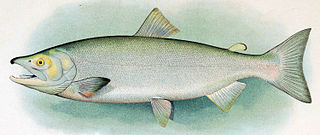
Sockeye salmon, also called red salmon, kokanee salmon, or blueback salmon, is an anadromous species of salmon found in the Northern Pacific Ocean and rivers discharging into it. This species is a Pacific salmon that is primarily red in hue during spawning. They can grow up to 84 cm in length and weigh 2.3 to 7 kg (5–15 lb). Juveniles remain in freshwater until they are ready to migrate to the ocean, over distances of up to 1,600 km (1,000 mi). Their diet consists primarily of zooplankton. Sockeye salmon are semelparous, dying after they spawn. Some populations, referred to as kokanee, do not migrate to the ocean and live their entire lives in freshwater.

The rainbow trout is a trout and species of salmonid native to cold-water tributaries of the Pacific Ocean in Asia and North America. The steelhead is an anadromous (sea-run) form of the coastal rainbow trout(O. m. irideus) or Columbia River redband trout (O. m. gairdneri) that usually returns to fresh water to spawn after living two to three years in the ocean. Freshwater forms that have been introduced into the Great Lakes and migrate into tributaries to spawn are also called steelhead.
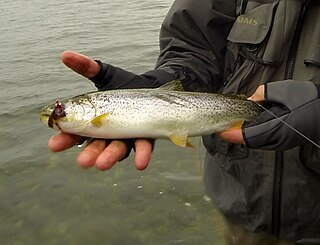
The coastal cutthroat trout also known as the sea-run cutthroat trout, or harvest trout is one of the several subspecies of cutthroat trout found in Western North America. The coastal cutthroat trout occurs in four distinct forms. A semi-anadromous or sea-run form is the most well known. Freshwater forms occur in both large and small rivers and streams and lake environments. The native range of the coastal cutthroat trout extends south from the southern coastline of the Kenai Peninsula in Alaska to the Eel River in Northern California. Coastal cutthroat trout are resident in tributary streams and rivers of the Pacific basin and are rarely found more than 100 miles (160 km) from the ocean.
With the removal of the Elwha Dam in 2012, the native salmonids began a return to their anadromous lifestyle, with spawning activities of true anadromous Chinook salmon observed in late 2013. [1]

Salmonidae is a family of ray-finned fish, the only living family currently placed in the order Salmoniformes. It includes salmon, trout, chars, freshwater whitefishes, and graylings, which collectively are known as the salmonids. The Atlantic salmon and trout of the genus Salmo give the family and order their names.

The Chinook salmon is the largest species in the Pacific salmon genus Oncorhynchus. The common name refers to the Chinookan peoples. Other vernacular names for the species include king salmon, Quinnat salmon, spring salmon, chrome hog, and Tyee salmon. The scientific species name is based on the Russian common name chavycha (чавыча).

